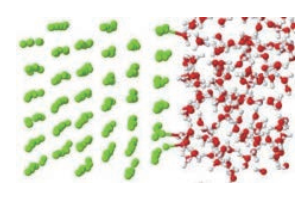Andrew P・ Horsfield。Richard Michael Fogarty1, Bingxin Li1, Nicholas M Harrison1
1 Department of Materials and Thomas Ybung Centre, Imperial College London, South
Kensington Campus, London SW7 2AZ, United Kingdom
EXTENDED ABSTRACT: Mg is interesting for structural applications because of its low density and high strength-to- weight ratio. However, it is also susceptible to aqueous corrosion. For many applications this is an undesirable property, though for medical implants it is a feature that can be beneficial if tuned appropriately. Many characteristics of the corrosion
of Mg are well established (such as the effect of alloying elements), but we still lack a detailed understanding of the atomic scale mechanisms. Atomic simulations are naturally suited for investigations into these mechanisms. We have employed Density Functional Theory simulations (both static and molecular dynamics) to study the interaction of water with a pristine Mg(0001) surface, and a surface coated in OH groups.
Keywords: Work functions; Chemical bonding; Probability theory; Ab- initio molecular dynamics; Car-Parrinello molecular dynamics; Corrosion;
Density functional theory; Adsorption.

REFERENCES
[1] Fogarty, Richard & Li, Bingxin & Harrison, Nicholas & Horsfield, Andrew. (2022). Structure and Interactions at the Mg(0001)/Water Interface: An ab initio Study. The Journal of Chemical Physics. 156. 10.1063/5.0093562.
[2] Fogarty, Richard & Horsfield, Andrew. (2022). Molecular Dynamics Study of Structure and Reactions at the Hydroxylated Mg(0001)/Bulk Water Interface. The Journal of Chemical Physics. 10.1063/5.0105828.

Andrew Horsfield is a Professor at the Materials Department of Imperial College London. He is a member of the Thomas Young Centre. His main current research interest is the simulation of the corrosion of Mg. Previous to this he was in charge of the theory core project for the IRC in Nanotechnology at UCL where he developed a novel scheme for non-adiabatic molecular dynamics (Correlated Electron-Ion Dynamics). His interest in efficient electronic structure methods and the development of two electronic structure codes (Plato and OXON) occurred while working in the Department of Materials at Oxford University with Prof David Pettifbr and Prof Adrian Sutton. This built on his experience with tight binding while studying liquid silicon with Prof Paulette Clancy at Cornell University as a PDRA and Junior Lecturer. He obtained his PhD in Physics from Cornell University.